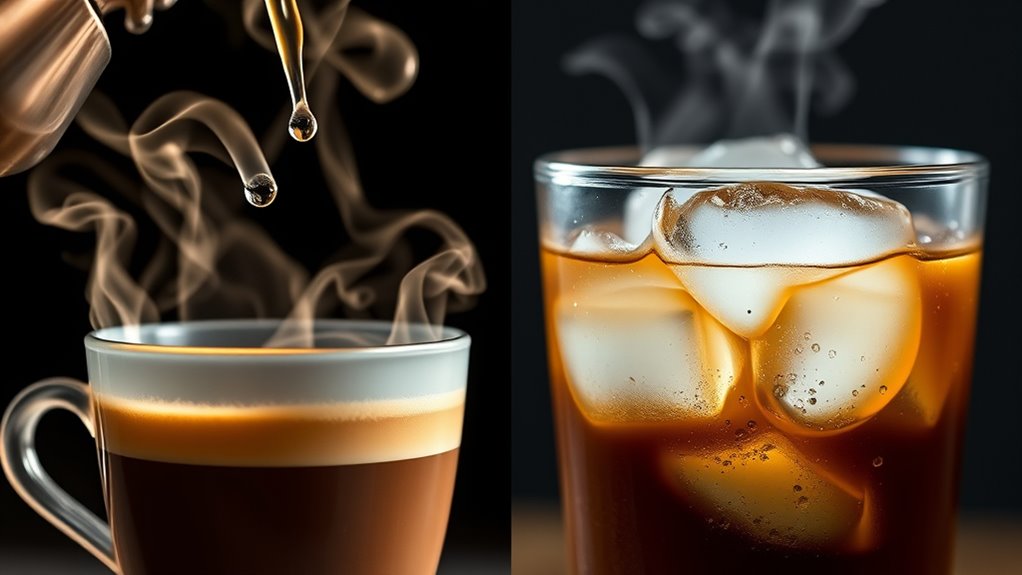When comparing cold throw and hot throw, you need to recognize that cold throw is the scent you notice before lighting the candle, while hot throw is the aroma released when it’s lit and the wax melts. Many beginners overlook that a strong cold throw doesn’t guarantee a good hot throw, which affects how well the fragrance fills a room. Understanding both helps you choose better candles—keep exploring to learn how these factors influence scent performance.
Key Takeaways
- Cold throw is the fragrance perceived when the candle is unlit, while hot throw occurs when the candle is burning and wax melts.
- Hot throw indicates how well the fragrance blends with wax and its ability to fill a room with scent.
- Cold throw can be misleading, as a strong initial scent doesn’t always guarantee a strong hot throw.
- Hot throw reflects the effectiveness of scent diffusion during burning, impacting overall aroma experience.
- Both throws are essential for evaluating a candle’s fragrance performance and predicting long-term scent longevity.

When it comes to candle-making, understanding the difference between a cold throw and a hot throw is essential for achieving the perfect scent experience. The cold throw refers to the aroma you notice when the candle is unlit and not yet warmed by a flame. It’s what you smell just by holding the candle close or even when it’s sitting on a shelf. This initial scent can give you a good idea of the fragrance’s strength, but it’s not the full story. The hot throw, on the other hand, is what fills the room when the candle is lit and the wax melts. It’s the scent that’s actively diffused into the air, creating ambiance and atmosphere. As you can see, both throws are vital in evaluating a candle’s overall fragrance performance.
Understanding scent diffusion is key here. A candle’s hot throw indicates how well the fragrance oils are effectively blending with the wax and releasing a noticeable aroma once lit, which is an important aspect of fragrance diffusion. If the hot throw is strong, it means the fragrance oils are effectively blending with the wax and releasing a noticeable aroma once lit. Conversely, a weak hot throw suggests that either the fragrance load is too low or the wax isn’t releasing the scent efficiently. This is where scent diffusion becomes a critical factor in candle design. You want a balance so that the scent is noticeable but not overwhelming. The cold throw, however, can sometimes be misleading. A candle might smell wonderful when unlit but fail to produce a strong hot throw once lit, which can be disappointing after purchase.
Fragrance longevity also ties into this. A good hot throw doesn’t just mean immediate scent release; it should also maintain its intensity over time. If your candle’s fragrance diminishes quickly after a few hours, the scent’s longevity is compromised. Manufacturers often manipulate fragrance load and wax composition to enhance both scent diffusion and longevity. For you, understanding this helps in selecting candles that will keep their aroma consistent during use. Keep in mind that some fragrances may have an impressive cold throw but fade rapidly when lit, while others might develop a more robust scent only when warmed. Recognizing this difference helps you set realistic expectations for your candle’s performance.
Frequently Asked Questions
How Does Candle Size Affect Cold and Hot Throw?
Your candle size directly impacts scent diffusion, affecting both cold and hot throw. Larger candles have more wax, allowing for a bigger melt pool that releases scent more effectively. Smaller candles, with less wax, may not disperse aroma as strongly when unlit or lit. Choosing the right candle size guarantees ideal scent diffusion, so you get a balanced and pleasing aroma whether the candle is cold or hot.
Can Scent Oils Influence the Difference Between Cold and Hot Throw?
Scent oils can influence the difference between cold and hot throw through scent concentration and oil blending. Higher scent concentration can enhance both throws, making the aroma stronger when unlit and lit. Proper oil blending ensures balanced scent release, so your candle smells great in both states. Experiment with different blends and concentrations to achieve a consistent, pleasing aroma, guaranteeing your candle’s scent remains enthralling whether cold or hot.
What Role Does Wick Type Play in Scent Throw?
Wick type plays a key role in your candle’s scent throw, much like a conductor guiding an orchestra. You need the right wick material and size to guarantee proper wax melting and scent release. A larger wick or one with better heat conduction can boost hot throw, while a smaller or slower wick might mellow the scent. Choose wisely to create a balanced, engaging aroma experience.
Do Different Wax Types Impact Cold and Hot Throw?
Different wax types definitely impact both cold and hot throw, influencing how your candle’s scent layers and fragrance longevity. For example, soy wax often offers a gentle scent release during cold scent layering, but may not project as strongly when hot. Paraffin wax tends to have a more vibrant hot throw, enhancing fragrance longevity. Choosing the right wax depends on your desired scent experience and how you want your candle to perform.
How Does Ambient Temperature Impact Scent Release During Burning?
Ambient influence and temperature variance notably impact scent release during burning. When the ambient temperature rises, your candle’s hot throw intensifies, spreading fragrance more effectively. Conversely, cooler environments may dampen scent diffusion, making it seem weaker. You should consider how your space’s temperature fluctuates, as these changes can alter the candle’s aroma experience. Adjusting placement or room temperature can help optimize scent release and guarantee a more consistent fragrance throughout your burn.
Conclusion
Understanding the difference between cold throw and hot throw isn’t just technical—it’s essential. While cold throw offers a fleeting glimpse of the scent, hot throw reveals the full, rich aroma after the wax melts and warms. Ignoring this contrast means missing out on the true depth of your candle’s fragrance. So, embrace both phases; after all, a candle’s aroma isn’t fully appreciated until it’s experienced in both the cold and the heat.










